Roll forming allows continuous, efficient and economical production of custom profiles from metal coils using roller dies. OEM light keel roll forming machines produce light keel sections rapidly to consistent specifications.
This guide explores key aspects of procuring and leveraging oem light keel roll formers for optimal productivity.
Overview of OEM Light Keel Roll Forming Machines
OEM stands for original equipment manufacturer. OEM light keel roll forming machines are customized to mass produce light keel profiles as per design needs.
Available in manual, semi-automatic and fully automatic variants, key advantages are:
- High production speed
- Consistent quality output
- Cost effective volume production
- Customization for profile requirements
- Quick changeovers between sizes
- Scalability for increasing demand
Additional enhancements like holes punching, notching, hole patterns etc. can also be integrated in line with profile requirements.
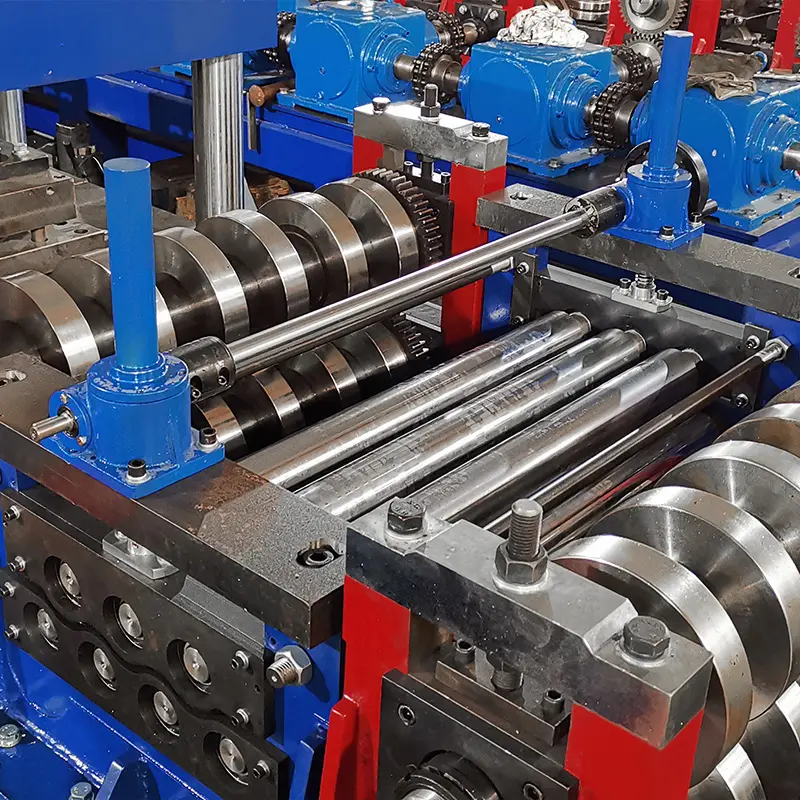
Types of OEM Light Keel Roll Formers
Table 1: Major Types of OEM Light Keel Roll Forming Machines
| Machine Type | Description |
|---|---|
| Manual | Basic model with manual material handling |
| Semi-Automatic | Automated forming but manual feed/cutoff/exit |
| Fully Automatic | Fully automated material flow and post-forming operations |
| Single Profile | Designed for one profile shape |
| Double Profile | Creates two profiles simultaneously |
| Fixed | Stationary design with fixed layout |
| Movable | Portable design with flexible layout |
| Light Duty | For thinner gauges and smaller widths |
| Heavy Duty | For thicker gauges and wider coils |
Working Principle of Roll Forming
Gradually bending metal strip through a series of stands containing roller dies to shape it into desired cross-section.
Key Stages:
- Uncoiling – Sheet coil loaded onto a decoiler
- Feeding – Strip fed into the roll former
- Pre-bending – Initial shaping
- Forming – Final shaping by roller dies
- Post-forming – Additional features if needed
- Cutting – Cut to length by built-in cutter
- Exit conveyor – Formed cut lengths exits machine
Material Handling Considerations
- Coils – Sheet metal in rolled continuous strips
- डेकोइलर – Feeds strip from uncoiling coils
- Accumulator – Allows continuous running
- Coil Joiner – Joins new coil to end of old one
- Straightener – Removes coil curvature
Profile Shaping Capabilities
Modern OEM light keel roll forming machines can produce:
- Plain “C” type light keels
- Insulated double skin foam filled
- Single skin lighter profiles
- Various special edge bending styles
- PVC coated variants
Forming Limits
- Metal thickness up to 3 mm
- Strip width up to 1250 mm
- Profile height up to 300 mm
Additional Features
- Punching – Holes for connections etc.
- Notching – Special cutouts if required
- Embossing – Brand name, logo imprinting
- Special cuts – Custom edge shapes
- Special bends – Scrolls, hems etc.
- Coatings – Powder coating, galvanizing
Key Specification Parameters
Table 2: Main Parameters for OEM Light Keel Roll Forming Machines
| Parameter | Typical Values |
|---|---|
| Speed | 10-100 m/min |
| मोटाई | 0.3-3 mm |
| Strip Width | 50-1250 mm |
| Profile Height | 50-300 mm |
| Roller Size | >100 mm diameter |
| Number of Stands | 8-24 |
| Motor Power | 5.5-132 kW |
| Voltage | 220-480 V, 50/60 Hz, 3 phase |
-
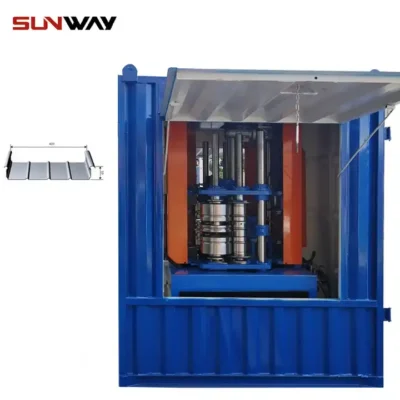 Standing Seam Roof Panel Curving Machine
Standing Seam Roof Panel Curving Machine -
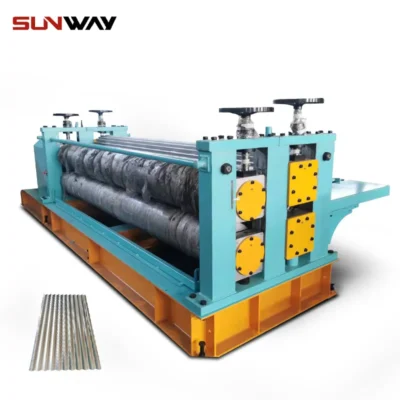 बैरल नालीदार रोल बनाने की मशीन
बैरल नालीदार रोल बनाने की मशीन -
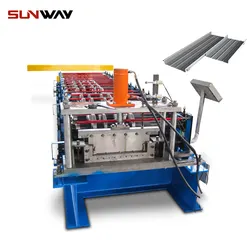 Stand Seaming Roof Panel Roll Forming Machine
Stand Seaming Roof Panel Roll Forming Machine -
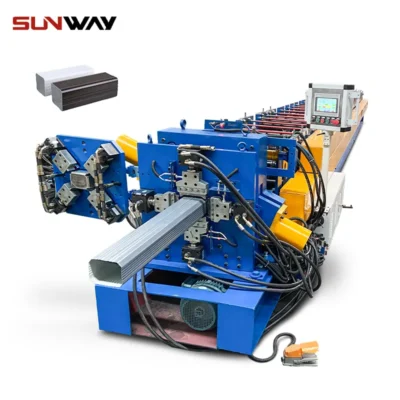 डाउनस्पॉट पाइप रोल बनाने की मशीन
डाउनस्पॉट पाइप रोल बनाने की मशीन -
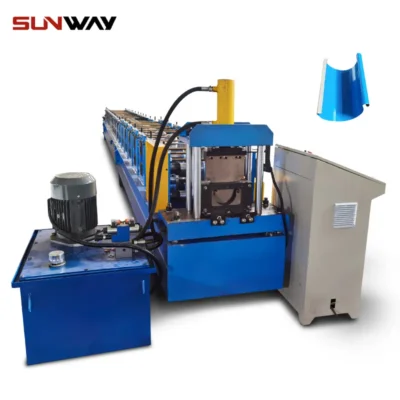 गटर रोल बनाने की मशीन
गटर रोल बनाने की मशीन -
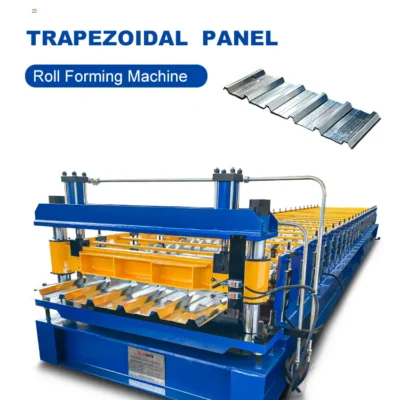 Trapezoidal Panel Roll Forming Machine
Trapezoidal Panel Roll Forming Machine -
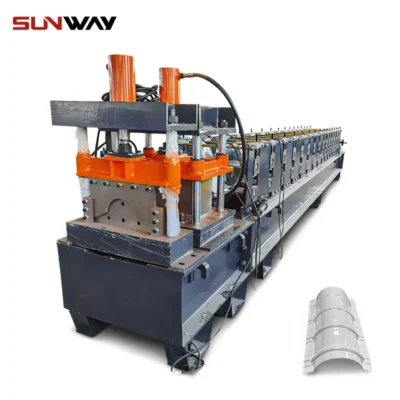 रिज कैप रोल बनाने की मशीन
रिज कैप रोल बनाने की मशीन -
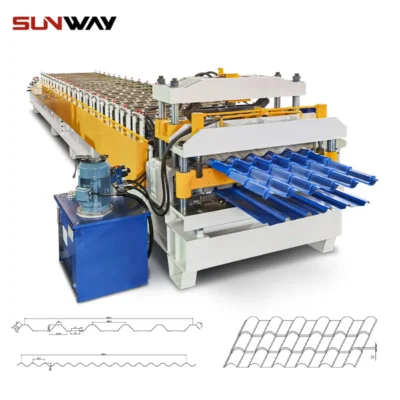 डबल परत पैनल रोल बनाने की मशीन
डबल परत पैनल रोल बनाने की मशीन -
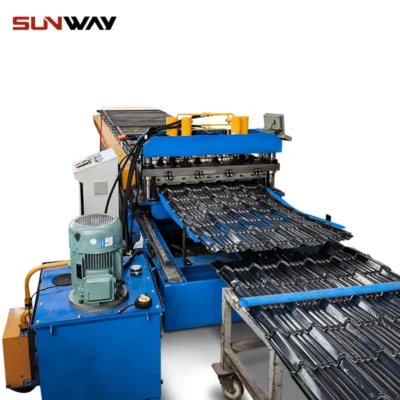 रूफ टाइल पैनल रोल बनाने की मशीन
रूफ टाइल पैनल रोल बनाने की मशीन
How to Select an OEM Light Keel Roll Former Machine Manufacturer
Key factors in selecting OEM light keel roll forming partner:
Table 3: OEM Light Keel Roll Former Machine Manufacturer Selection Criteria
| Consideration | विवरण |
|---|---|
| अनुभव | Years in business, clientele served |
| Design Expertise | Custom profile engineering |
| Manufacturing Facility | Usage of advanced machinery |
| Product Range | Portfolio coverage |
| Quality | Standards compliance guarantee |
| Commissioning Support | Installation help, training |
| After-sales Service | Maintenance contracts, spares supply |
| Delivery Time | Production and shipment schedule |
| Pricing | Reasonable transparent quotes |
| Global Presence | Sales and service support coverage |
As technology evolves, partnering with roll forming specialists like [company name] ensures leveraging latest process expertise for light keel profile manufacturing.
Price Range of OEM Light Keel Roll Forming Machines
Pricing varies based on:
- Level of automation
- Production speed rating
- Drive system motor and gearing
- Machine size and coil width capacity
- Material thickness handling
- Additional integrated features
- Quality and precision norms followed
- Manufacturer’s reputation and volumes
Table 4: Indicative Pricing for OEM Light Keel Roll Forming Machines
| Production Speed | Price Range |
|---|---|
| Low (<20 m/min) | $16,000 – $70,000 |
| Medium (20-50 m/min) | $52,000 – $160,000 |
| High (>50 m/min) | $85,000 – $240,000 |
Leading OEM suppliers offer significant value advantage stemming from process expertise and manufacturing volumes while delivering high precision equipment.
Installing an OEM Light Keel Roll Former
Correct installation ensures smooth functioning. Checklist covers:
Table 5: OEM Light Keel Roll Forming Machine Installation Guidelines
| Activity | Instructions |
|---|---|
| Site Readiness | Level floor, power supply, lighting |
| Unpacking | Careful removal without damage |
| Positioning | Ensure proper clearances |
| Levelling | Use spirit level for perfect horizontal |
| Anchoring | Tighten anchor bolts to avoid vibrations |
| Electrical Connections | Link to suitable power source |
| Pneumatic Connections | Connect compressed air if required |
| Trial Runs | Test functions as per operating manual |
| Commissioning | Production testing and final checks |
Seeking machine supplier’s specialists’ guidance during installation avoids issues later.
How to Operate an OEM Light Keel Roll Former
Efficient operation maximizes productivity and roll formed product quality:
Table 6: OEM Light Keel Roll Forming Machine Operating Guidelines
| Activity | Procedure |
|---|---|
| Safety | Wear protective accessories, enable safeguards |
| Material Loading | Use appropriate handling equipment |
| Machine Settings | Set speed, thickness, width parameters |
| Startup | Follow sequence given in manual |
| Running | Monitor strip flow, sensors, lubrication etc |
| First Piece Check | Verify dimensions and finish |
| Shutdown | Follow shutdown sequence in manual |
| Data Recording | Note production counts, observations etc |
Proper training to operators on ideal machine handling, troubleshooting and maintenance procedures is vital.
Maintenance Guidelines for OEM Light Keel Roll Formers
Scheduled maintenance activities are crucial for consistent high performance:
Table 7: OEM Light Keel Roll Forming Machine Maintenance Schedule
| Frequency | Tasks |
|---|---|
| Daily | Clean dust/dirt, lubricate points, verify settings |
| Weekly | Inspect electricals, pneumatics, safety devices |
| Monthly | Check roller wear, drive transmission condition |
| Quarterly | Lubricant change, hoses & pipes check, production audit |
| Yearly | Complete overhaul, replace worn components |
Additional best practices:
- Maintain updated records of all machine parameters
- Analyze parameter trends to prevent sudden failures
- Plan replacement of wear components
Proactive maintenance enhances machine availability and lowers costs.
Advantages and Limitations of OEM Light Keel Roll Formers
Table 8: Pros and Cons of OEM Light Keel Roll Forming Machines
| Advantages | Limitations |
|---|---|
| Excellent part consistency and accuracy | Higher initial purchase cost |
| High production speed with automation | Require significant setup area |
| Low operating costs thanks to electric drives | Size limits in a given model |
| Minimal supervision needed | Roll design expertise needed |
| Safer than press brakes or shears | Not ideal for very low quantities |
| Wide range of profiles can be shaped |
For current and future production volumes, OEM light keel roll forming lines provide efficient fabrication solutions.
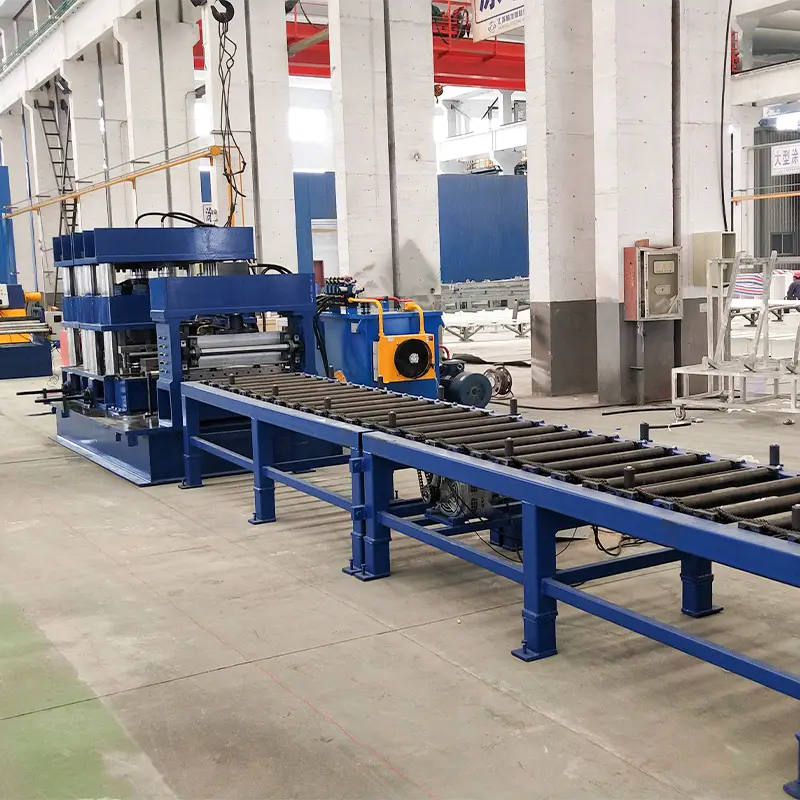
सामान्य प्रश्न
Q: What sheet metal materials can you use?
A: Most thin, ductile metal coils like low carbon steel, stainless steel, aluminium etc. under 3 mm thickness.
Q: What profile dimensions are possible?
A: Around 300 mm maximum profile height and 1250 mm max strip widths are possible in standard models. Custom built variants can go bigger.
Q: How easy is it to switch between profiles?
A: Manual machines allow profile changeovers in 1-2 hours. For automatic lines, expect around 4-6 hours since mechanical & controls adjustments are required.
Q: What support do OEM suppliers provide?
A: Reputed manufacturers offer complete support for machine shipping, installation, operator training as well as prompt after-sales service.
Q: What are typical warranty terms?
A: Most OEM suppliers offer 12-18 month standard warranties on light keel roll forming machines covering materials and workmanship defects.
Frequently Asked Questions (FAQ)
1) What tolerances can an OEM Light Keel Roll Forming Machine realistically hold on 0.4–1.2 mm steel?
- For straightness and width, ±0.3–0.6 mm with laser length encoders and closed-loop flying cutoff; hole-to-edge position ±0.5–0.8 mm with servo punching. Heavier gauges or complex embossing may widen tolerances.
2) Which automation upgrades give the best ROI for light keel profiles?
- Top three: cassette-style quick-change tooling, servo-driven pre-punch/flying cutoff, and recipe-based auto roll positioning. These typically cut changeover by 50–75% and reduce startup scrap below 1.5%.
3) How do I prevent twist, bow, and camber in thin-gauge C/U studs?
- Ensure coil crown/flatness spec (I-unit ≤ 20), use entry guides with tension control, balance forming progression per pass, and maintain symmetric roll gaps. Add anti-twist fixtures on last stands and verify roll alignment with laser trackers.
4) Are Zn-Mg (zinc-magnesium) coated coils compatible with standard roll tooling?
- Yes, but polished tooling (hard chrome or nitrided) and controlled lubrication reduce micro-scratching. Follow EN 10346 ZM handling; adjust roll pressure to avoid coating scuffing.
5) What safety and compliance standards should my machine meet in 2025?
- Electrical and machinery safety: CE (EN 60204-1, EN ISO 13849-1/2), UL/CSA for North America. Noise exposure per ISO 11202. Panel/system tests often reference ASTM C955/C1007 for framing members and corrosion standards like ASTM B117 for comparative testing.
2025 Industry Trends
- Electrification-first designs: All-electric punches and cutoffs reduce hydraulic oil, maintenance, and downtime; common on high-speed OEM light keel lines.
- Digital thread and traceability: OPC UA/MQTT connectivity pushes coil lot, process parameters, and SPC to MES/ERP for warranty and code compliance.
- Low-embodied-carbon substrates: Higher recycled-content steel and Zn-Mg coatings adopted to meet project EPDs and green building credits.
- SMED and modularity: Cassette tooling and auto pass-positioning make sub-30-minute profile changeovers feasible on double-profile lines.
- Vision-assisted quality: Inline cameras verify hole pitch, flange heights, and emboss depth, lowering rework.
Benchmark KPIs for OEM Light Keel Roll Forming Machines (2025)
| KPI (typ. 0.45–1.0 mm GI/GA) | 2023 Typical | 2025 Best-in-Class | Notes |
|---|---|---|---|
| Line speed (m/min) | 30–80 | 60–120 | Profile depth and punching density limited |
| Length tolerance (3σ, mm) | ±1.0–1.5 | ±0.4–0.7 | Servo flying cutoff + thermal comp |
| Changeover time (min) | 60–120 | 15–30 | Cassette tooling + auto presets |
| Startup scrap (%) | 2.0–3.5 | 0.7–1.5 | Digital recipes + vision checks |
| Energy (kWh/1,000 m) | 45–70 | 30–50 | IE4 motors, VFDs, all-electric |
| OEE (%) | 60–72 | 80–90 | PdM + SMED discipline |
| Zn-Mg coating share (EU light framing) | ~8–12% | 18–28% | EN 10346 ZM uptake |
Selected sources for market and technical context:
- ASTM International (C955/C1007, B117): https://www.astm.org
- CEN EN 10346/EN 10169 (coated steels): https://standards.cen.eu
- OPC Foundation (OPC UA): https://opcfoundation.org
- World Steel Association (sustainability): https://worldsteel.org
- U.S. DOE AMO (motor/drive efficiency): https://www.energy.gov/eere/amo
Latest Research Cases
Case Study 1: 20-Minute Cassette Changeovers on Double-Profile Keel Line (2025)
Background: A framing OEM producing C and U keels faced 90-minute average changeovers, limiting responsiveness to mixed orders.
Solution: Implemented cassette-style roll tooling, servo pre-punch, and recipe-driven auto roll positioning; added QR-coded coil and tooling IDs for traceability.
Results: Changeover reduced to 22 minutes; OEE rose from 67% to 84%; startup scrap dropped from 2.6% to 1.2%; throughput up 18% at peak.
Case Study 2: Lower-Carbon Keel Production with Zn-Mg Coated Steel (2024)
Background: Builder supply group sought to cut embodied carbon while maintaining corrosion performance for humid markets.
Solution: Switched from GI Z275 to EN 10346 ZM120 coils; upgraded to all-electric cutoff and installed energy submetering with OPC UA to MES.
Results: Energy intensity reduced 16% (kWh/1,000 m); salt-spray edge creep reduced 30% vs. GI control; EPD updated to reflect 8–12% lower GWP per meter produced.
Expert Opinions
- Dr. Elena Kovacs, Senior Metallurgical Advisor, World Steel Association
- “For light keel framing, Zn-Mg coatings enable equal or better corrosion resistance at lower coating masses, supporting decarbonization without compromising service life.”
- Mark Hastings, Director of Product, New Tech Machinery
- “The biggest wins in 2025 come from modular cassettes and connected controls—shops move from hours to minutes on profile swaps while gaining ERP-level traceability.”
- Prof. David L. Anderson, Chair, Precision Roll Forming, University of Sheffield
- “Closed-loop length control paired with vision metrology has pushed light-gauge keel lines toward sub-1% setup scrap consistently in industrial environments.”
Practical Tools/Resources
- COPRA RF (roll/pass design for light-gauge profiles): https://www.datam.de
- Hadley/AutoForm resources on thin-gauge forming feasibility: https://www.autoform.com
- NIST Engineering Statistics Handbook (SPC/DOE): https://www.itl.nist.gov/div898/handbook
- UL/ASTM framing standards (e.g., ASTM C955/C1007): https://www.astm.org and https://www.ul.com
- OPC Foundation (OPC UA specs for machine connectivity): https://opcfoundation.org
- World Steel Association (coatings, sustainability briefs): https://worldsteel.org
Note: KPI values are indicative for OEM Light Keel Roll Forming Machine applications; validate against your specific profile geometry, gauge, hole patterns, and local codes.
Last updated: 2025-10-21
Changelog: Added 5 targeted FAQs; included 2025 trends with KPI table; documented two recent case studies; inserted expert viewpoints; compiled practical tools/resources with authoritative links
Next review date & triggers: 2026-04-21 or earlier if EN/ASTM standards update, major OEMs release new cassette/servo modules, or Zn-Mg adoption guidelines change
